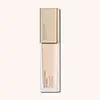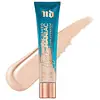BeautyAct Luminous Complexion Foundation Versus Urban Decay Hydromaniac Tinted Glow Hydrator Foundation
What's inside
What's inside
 Key Ingredients
Key Ingredients

 Benefits
Benefits

 Concerns
Concerns

 Ingredients Side-by-side
Ingredients Side-by-side

Water
Skin ConditioningCyclopentasiloxane
EmollientPhenyl Trimethicone
Skin ConditioningC12-15 Alkyl Benzoate
AntimicrobialButylene Glycol
HumectantTalc
AbrasiveCetyl PEG/PPG-10/1 Dimethicone
EmulsifyingPolyglyceryl-4 Isostearate
EmulsifyingSodium Chloride
MaskingVinyl Dimethicone/Methicone Silsesquioxane Crosspolymer
Phenoxyethanol
PreservativePolymethylsilsesquioxane
Dimethicone/Vinyl Dimethicone Crosspolymer
Skin ConditioningDisteardimonium Hectorite
StabilisingSodium Dehydroacetate
PreservativeAlumina
AbrasiveHydrogen Dimethicone
Xanthan Gum
EmulsifyingAluminum Hydroxide
EmollientSodium Gluconate
Skin ConditioningEthylhexylglycerin
Skin ConditioningHelianthus Annuus Seed Oil
EmollientTocopherol
AntioxidantBeta-Sitosterol
Emulsion StabilisingSqualene
EmollientCI 77891
Cosmetic ColorantCI 77492
Cosmetic ColorantCI 77499
Cosmetic ColorantCI 77491
Cosmetic ColorantWater, Cyclopentasiloxane, Phenyl Trimethicone, C12-15 Alkyl Benzoate, Butylene Glycol, Talc, Cetyl PEG/PPG-10/1 Dimethicone, Polyglyceryl-4 Isostearate, Sodium Chloride, Vinyl Dimethicone/Methicone Silsesquioxane Crosspolymer, Phenoxyethanol, Polymethylsilsesquioxane, Dimethicone/Vinyl Dimethicone Crosspolymer, Disteardimonium Hectorite, Sodium Dehydroacetate, Alumina, Hydrogen Dimethicone, Xanthan Gum, Aluminum Hydroxide, Sodium Gluconate, Ethylhexylglycerin, Helianthus Annuus Seed Oil, Tocopherol, Beta-Sitosterol, Squalene, CI 77891, CI 77492, CI 77499, CI 77491
Water
Skin ConditioningPhenyl Trimethicone
Skin ConditioningDicaprylyl Ether
EmollientGlycerin
HumectantTriethylhexanoin
MaskingCetyl PEG/PPG-10/1 Dimethicone
EmulsifyingDextrin Myristate
EmulsifyingHydrogenated Styrene/Methylstyrene/Indene Copolymer
PEG-8
HumectantSynthetic Fluorphlogopite
Pentylene Glycol
Skin ConditioningPolyglyceryl-4 Isostearate
EmulsifyingSodium Chloride
MaskingPhenoxyethanol
PreservativeDisodium Stearoyl Glutamate
CleansingChlorphenesin
AntimicrobialEthyl Menthane Carboxamide
TonicSaccharomyces/Xylinum/Black Tea Ferment
Skin ConditioningAluminum Hydroxide
EmollientPentaerythrityl Tetra-Di-T-Butyl Hydroxyhydrocinnamate
AntioxidantTocopherol
AntioxidantHydroxyethylcellulose
Emulsion StabilisingArgania Spinosa Kernel Oil
EmollientSclerocarya Birrea Seed Oil
HumectantZingiber Officinale Root Extract
MaskingSodium Citrate
BufferingCitric Acid
BufferingPotassium Sorbate
PreservativeBiotin
AntiseborrhoeicTitanium Dioxide
Cosmetic ColorantCI 77491
Cosmetic ColorantCI 77492
Cosmetic ColorantCI 77499
Cosmetic ColorantWater, Phenyl Trimethicone, Dicaprylyl Ether, Glycerin, Triethylhexanoin, Cetyl PEG/PPG-10/1 Dimethicone, Dextrin Myristate, Hydrogenated Styrene/Methylstyrene/Indene Copolymer, PEG-8, Synthetic Fluorphlogopite, Pentylene Glycol, Polyglyceryl-4 Isostearate, Sodium Chloride, Phenoxyethanol, Disodium Stearoyl Glutamate, Chlorphenesin, Ethyl Menthane Carboxamide, Saccharomyces/Xylinum/Black Tea Ferment, Aluminum Hydroxide, Pentaerythrityl Tetra-Di-T-Butyl Hydroxyhydrocinnamate, Tocopherol, Hydroxyethylcellulose, Argania Spinosa Kernel Oil, Sclerocarya Birrea Seed Oil, Zingiber Officinale Root Extract, Sodium Citrate, Citric Acid, Potassium Sorbate, Biotin, Titanium Dioxide, CI 77491, CI 77492, CI 77499
Ingredients Explained
These ingredients are found in both products.
Ingredients higher up in an ingredient list are typically present in a larger amount.
Aluminum Hydroxide is a form of aluminum. It can be naturally found in nature as the mineral gibbsite. In cosmetics, Aluminum Hydroxide is used as a colorant, pH adjuster, and absorbent.
As a colorant, Aluminum Hydroxide may add opacity, or reduce the transparency. Aluminum hydroxide is contains both basic and acidic properties.
According to manufacturers, this ingredient is an emollient and humectant. This means it helps hydrate the skin.
In medicine, this ingredient is used to help relieve heartburn and help heal ulcers.
There is currently no credible scientific evidence linking aluminum hydroxide in cosmetics to increased cancer risk.
Major health organizations allow the use of aluminum hydroxide in personal care products and have not flagged it as a carcinogenic risk at typical usage levels.
Learn more about Aluminum HydroxideThis ingredient is a high molecular weight silicone. It has emulsifying and skin conditioning properties.
Ci 77491 is also hydrated iron III oxide. It's sole purpose is to give a red/pink hue to products.
Iron III oxides are classified as inorganic chemicals for coloring.
Synthetically created Ci 77491 is considered safer than those naturally found. This is because the synthetically created version may contain less impurities. Iron oxides are generally non-toxic and non-allergenic.
Learn more about CI 77491Ci 77492 is also hydrated iron III oxide. It's sole purpose is to give a yellow hue to products.
Iron III oxides are classified as inorganic chemicals for coloring.
Synthetically created Ci 77492 is considered safer than those naturally found. This is because the synthetically created version may contain less impurities. Iron oxides are generally non-toxic and non-allergenic.
Learn more about CI 77492Ci 77499 is also hydrated iron III oxide. It is created from mixing red and black iron oxides. This helps give shades of darkness to a product.
Iron III oxides are classified as inorganic chemicals for coloring.
Phenoxyethanol is a preservative that has germicide, antimicrobial, and aromatic properties. Studies show that phenoxyethanol can prevent microbial growth. By itself, it has a scent that is similar to that of a rose.
It's often used in formulations along with Caprylyl Glycol to preserve the shelf life of products.
Phenyl Trimethicone is a silicon-based polymer. It is derived from silica.
Phenyl Trimethicone is used as an emollient and prevents products from foaming.
As an emollient, it helps trap moisture in the skin. It is considered an occlusive.
Learn more about Phenyl TrimethiconeThis ingredient is an emulsifer and stabilizer. It comes from isostearic acid and polyglycerin.
As an emulsifier, it helps blend oil and water to improve texture, spreadbility, and application.
Due to it being derived from isostearic acid, this ingredient may not be fungal acne safe.
Learn more about Polyglyceryl-4 IsostearateChances are, you eat sodium chloride every day. Sodium Chloride is also known as table salt.
This ingredient has many purposes in skincare: thickener, emulsifier, and exfoliator.
You'll most likely find this ingredient in cleansers where it is used to create a gel-like texture. As an emulsifier, it also prevents ingredients from separating.
There is much debate on whether this ingredient is comedogenic. The short answer - comedogenic ratings don't tell the whole story. Learn more about comegodenic ratings here.
The concensus about this ingredient causing acne seems to be divided. Research is needed to understand if this ingredient does cause acne.
Scrubs may use salt as the primary exfoliating ingredient.
Learn more about Sodium ChlorideTocopherol (also known as Vitamin E) is a common antioxidant used to help protect the skin from free-radicals and strengthen the skin barrier. It's also fat soluble - this means our skin is great at absorbing it.
Vitamin E also helps keep your natural skin lipids healthy. Your lipid skin barrier naturally consists of lipids, ceramides, and fatty acids. Vitamin E offers extra protection for your skin’s lipid barrier, keeping your skin healthy and nourished.
Another benefit is a bit of UV protection. Vitamin E helps reduce the damage caused by UVB rays. (It should not replace your sunscreen). Combining it with Vitamin C can decrease sunburned cells and hyperpigmentation after UV exposure.
You might have noticed Vitamin E + C often paired together. This is because it is great at stabilizing Vitamin C. Using the two together helps increase the effectiveness of both ingredients.
There are often claims that Vitamin E can reduce/prevent scarring, but these claims haven't been confirmed by scientific research.
Learn more about TocopherolWater. It's the most common cosmetic ingredient of all. You'll usually see it at the top of ingredient lists, meaning that it makes up the largest part of the product.
So why is it so popular? Water most often acts as a solvent - this means that it helps dissolve other ingredients into the formulation.
You'll also recognize water as that liquid we all need to stay alive. If you see this, drink a glass of water. Stay hydrated!
Learn more about Water